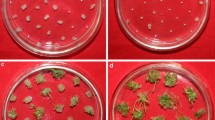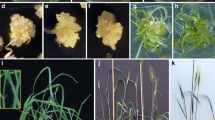Summary
The ability of immature embryos of wheat (Triticum aestivum L.) to respond to tissue culture has been shown to involve the group 2 chromosomes. The available group 2 ditelosomic and nullisomic-tetrasomic lines of ‘Chinese Spring’ wheat were used to determine the chromosome arm location and chromosome dosage effect associated with the expression of tissue culture response (TCR). Significant differences were found between the aneuploid lines and the euploid control for the expression of both regenerable callus formation and callus growth rate. A model is proposed suggesting that a major TCR gene is located on 2DL and that 2AL and 2BS possess minor TCR genes. Furthermore, a major regulatory gene controlling the expression of TCR genes may be located on chromosome 2BL.
Similar content being viewed by others
References
Brown JWS, Flavell RB (1981) Fractionation of wheat gliadin and glutenin subunits by two-dimensional electrophoresis and the role of group 6 and group 2 chromosomes in gliadin synthesis. Theor Appl Genet 59:349–359
Colas des Francs C, Thiellement H (1985) Chromosomal localization of structural genes and regulators in wheat by 2D electrophoresis of ditelosomic lines. Theor Appl Genet 71:31–38
Felsenburg T, Feldman M, Galun E (1987) Aneuploid and alloplasmic lines as tools for the study of nuclear and cytoplasmic control of culture ability and regeneration of sentellar calli from common wheat. Theor Appl Genet 74:802–810
Gale MD, Youseffian S (1985) Dwarfing genes in wheat. In: Russell GE (ed) Progress in plant breeding, vol 1. Butterworths, London, pp 1–35
Galiba G, Kovacs G, Sutka J (1986) Substitution analysis of plant regeneration from callus culture in wheat. Plant Breed 97:261–263
Higgins P, Mathias RJ (1987) The effect of the 4B chromosomes of hexaploid wheat on the growth and regeneration of callus cultures. Theor Appl Genet 74:439–444
Hodges TK, Kamo KK, Imbrie CW, Becwar MR (1986) Genotype specificity of somatic embryogenesis and regeneration in maize. Biotechnology 4:219–223
Kaleikau EK (1988) Chromosomal location of genes controlling tissue culture response in wheat (Triticum aestivum L.). PhD thesis, Kansas State University
Lazar MD, Collins GB, Vian WE (1983) Genetic and environmental effects on the growth an differentiation of wheat somatic cell cultures. J Hered 74:353–357
Lazar MD, Chen THH, Scoles GJ, Kartha KK (1987) Immature embryo and anther culture of chromosome addition lines of rye in Chinese Spring wheat. Plant Sci 51:77–81
Maddock SE, Lancaster VA, Risiott R, Franklin J (1983) Plant regeneration from cultured immature embryos and inflorescences of 25 cultivars of wheat (Triticum aestivum). J Exp Bot 34:915–926
Mathias RJ, Fukui K (1986) The effect of specific chromosome and cytoplasmic substitutions on the tissue culture response of wheat (Triticum aestivum) callus. Theor Appl Genet 71:797–800
Mathias RJ, Simpson ES (1986) The interaction of genotype and culture medium on tissue culture responses of wheat (Triticum aestivum L. em. thell) callus. Plant Cell Tiss Org Cult 7:31–37
McIntosh RA (1987) Gene location and gene mapping in hexaploid wheat. In: Heyne ED (ed) Wheat and wheat improvement, 2nd ed. ASA, CSSA, SSSA, pp 269–287
Salman R (1986) Genetic control of tissue culture response in winter wheat (Triticum aestivum L.). PhD thesis, Kansas State University
Scarth R, Law CN (1983) The location of the photoperiod gene, Ppd2 and an additional genetic factor for ear-emergence time on chromosome 2B of wheat. Heredity 51:607–619
Scarth R, Law CN (1984) The control of the day-length response in wheat by the group 2 chromosomes. Z Pflanzenzuecht 92:140–150
Sears ER (1966) Nullisomic-tetrasomic combinations in hexaploid wheat. Chromosome manipulation and plant genetics. Oliver and Boyd, London, pp 29–45
Sears RG, Deckard EL (1982) Tissue culture variability in wheat: Callus induction and plant regeneration. Crop Sci 22:546–550
Sears ER, Sears LM (1978) The telocentric chromosomes of common wheat. In: Proc 5th Int Wheat Genetics Symp, New Delhi, pp 389–407
Szakacs E, Kovacs G, Pank J, Barnabus B (1988) Substitution analysis of callus induction and plant regeneration from anther culture in wheat (Triticum aestivum L.). Plant Cell Rep 7:127–129
Thiellement H, Bahrman N, Colas des Francs C (1986) Regulatory effects of homoeologous chromosome arms on wheat proteins at two developmental stages. Theor Appl Genet 73:246–251
Welsh JR, Keim DL, Perasteel B, Richards RD (1973) Genetic control of photoperiod response in wheat. In: Proc 4th Int Wheat Genet Symp, Missouri, pp 879–884
Wolf G, Rimpau J, Lelley T (1977) Localization of structural and regulatory genes for phosphodiesterases in wheat (Triticum aestivum). Genetics 86:597–605
Author information
Authors and Affiliations
Additional information
Communicated by K. Tsunewaki
Rights and permissions
About this article
Cite this article
Kaleikau, E.K., Sears, R.G. & Gill, B.S. Control of tissue culture response in wheat (Triticum aestivum L.). Theoret. Appl. Genetics 78, 783–787 (1989). https://doi.org/10.1007/BF00266658
Received:
Accepted:
Issue Date:
DOI: https://doi.org/10.1007/BF00266658




